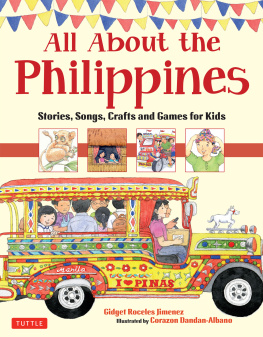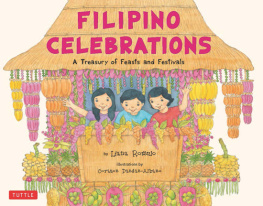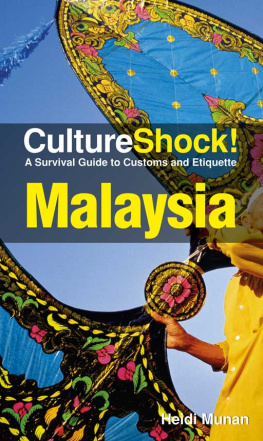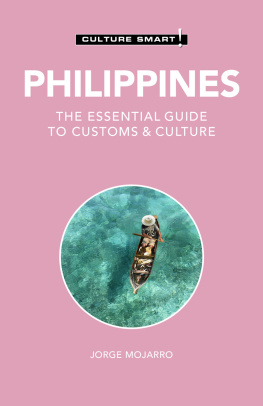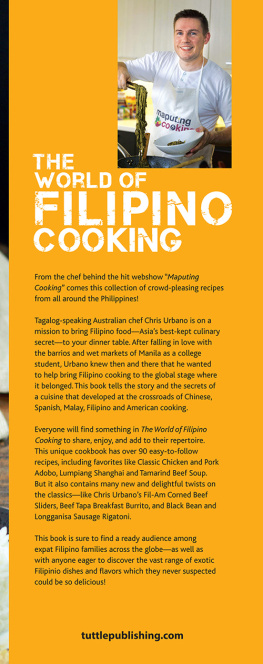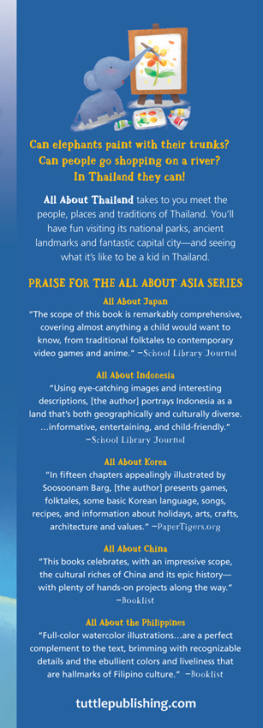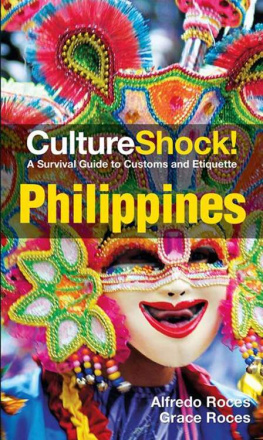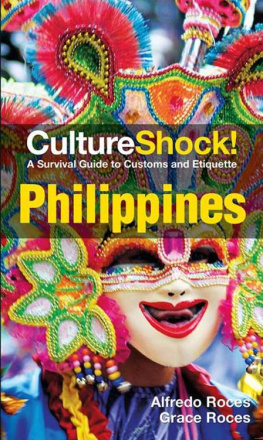
Mabuhay ! Welcome !
Meet Mary, Jaime and Ari

M y name is Mary Ong . My skin is pretty fair and I have straight black hair and almond-shaped eyes. I live in Mandaluyong City on Luzon, which is the largest Philippine island. My dads ancestors were Chinese merchants who first came to the Philippines more than 1000 years ago! My mom is descended from a tribe called Ifugao, who are famous for building the rice terraces in northern Luzon.

M y name is Jaime Lopez . I have big round eyes and a pointed nose and light brown hair. I live in Cebu, one of the main islands in Visayas. My dads ancestors go all the way back to the Spanish explorers that came to this country to claim it as a colony and spread Christianity.

M y name is Ari Abaza . I have curly black hair and my nose is kind of flat. I live in Zamboanga City on the island of Mindanao, which is where youll find most of this countrys Muslims. My dad is descended from Arab missionaries who came to the Philippines more than 700 years ago.

Together, we are a perfect blend,
just like the Filipino people.
So many different people make up this countryMalayo-Polynesians, Chinese, South Asian and Arab people who came looking for places to settle and trade. Spanish explorers and American soldiers also came here looking for spices and new lands to conquer.
Its no wonder that our country is known as a land of many different faces, a mix of different sorts of people who are all Filipinos.
Not Your Everyday Filipino
The Barong Tagalog
Jaime wears a barong tagalog on special occasions. The barong is a Philippine national costume for men. It is made from a delicate fabric called pia that is handwoven from pineapple fiber.
It is commonly believed that the barong may have originated as a uniform for Filipinos during Spanish colonial times. The shirts see-through material and tucked-out design with no pockets prevented the wearer from stealing or hiding weapons.

The Jeepney
When Mary misses her school bus, she takes a jeepney to school. A jeepney is a public mode of transportation that looks kind of like a colorful army jeep. After the American occupation, many surplus jeeps were left behind and converted for commercial use. Jeepneys are decorated according to the owners personal tastes, and each is unique. Many owners paint pictures of their family and religious icons, like Jesus, on their jeepney.


The Singkil and Tinikling
Ari and his friends love clapping bamboo poles for a popular Muslim dance called the singkil , named after the bells worn on the dancers ankles. In this dance, two sets of poles are criss-crossed and placed an equal and suitable distance apart. The dance is based on a legend about a Muslim princess who gets lost in a forest during an earthquake caused by mischievous fairies. Aris school teaches the singkil as part of Philippine culture, and many real-life Muslim princesses still perform the dance during important royal functions.
The tinikling is another dance that uses poles. This Luzon folk dance is believed to have originated as a form of punishment in the Spanish haciendas. Slow workers would be made to stand between two poles. If they didnt want the poles to strike their ankles, theyd have to jump out of the way. The dainty steps of this dance mimic the movements of the tikling (heron), a local bird considered a nuisance in the fields.
The Bahay Kubo
I s it really possible to pick up an entire house and move it to a different location in a single day? In the Philippines, counting on the Filipino community spirit of bayanihan can be a common occurrence, especially with the threat of flood during the typhoon season. The old town tradition involves all able-bodied men coming together to carry the house to a new location.
A bahay kubo is a cube-shaped house made from local natural materials of bamboo and nipa. It is built on wooden stilts as a protective measure against unwanted wild animals. It is also easier to uproot when the house needs to be transported to another location.


A popular song called Bahay Kubo describes a peaceful, abundant and contented life in this simple little house.
Bahay Kubo (Filipino)
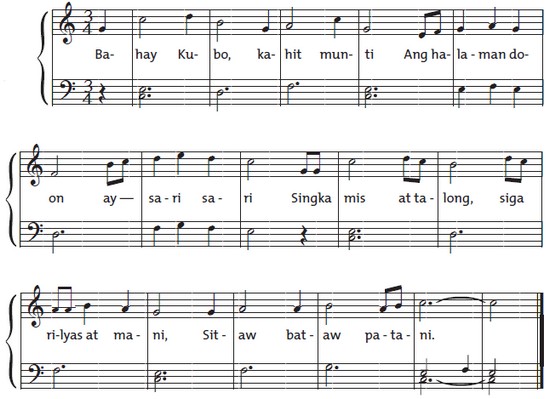
Nipa Hut (English)
Nipa hut, even though it is small
The plants it houses are varied
Turnip and eggplant, winged bean and peanut
String bean, hyacinth bean, lima bean.
Wax gourd, luffa, white squash and pumpkin,
And there is also radish, mustard,
Onion, tomato, garlic and ginger
And all around are sesame seeds.
Growing up in Luzon
T he main island of Luzon is my home. It is the largest and most populated island in the Philippines. Its also home to the largest number of ethnic groups in the country. Lots of the people here are of Austronesian or Malayo-Polynesian descent, like my mothers Ifugao tribe. Some people are descended from minority immigrants who came to trade and then settled in Manila, like my fathers Chinese ancestors.

The Malacanang Palace in Manila is the seat of the Philippine National Government, just like the White House is in the U.S.
A lot of Luzons population live in Metro Manila, which is a group of cities that has been the center of government and business since colonial times. People who live here come from many different places, but most of the people here speak Tagalog or Filipino and English. Most of them are Roman Catholics.


My parents and I live in Mandaluyong city, one of the sixteen cities that make up Metro Manila. We live in a three-story town house with my grandparents. We moved here from Binondo, the original Chinatown of Manila, so we could live closer to the private Chinese Catholic school that my parents picked for me. Lots of my schoolmates families moved to this area for its schools. Now our neighborhood is a kind of Chinatown, with lots of fantastic Chinese shops and restaurants.
Next page
